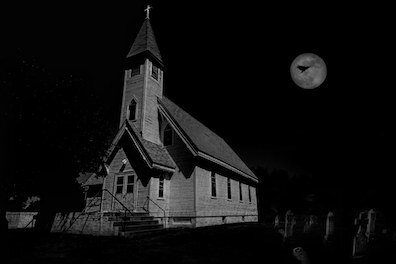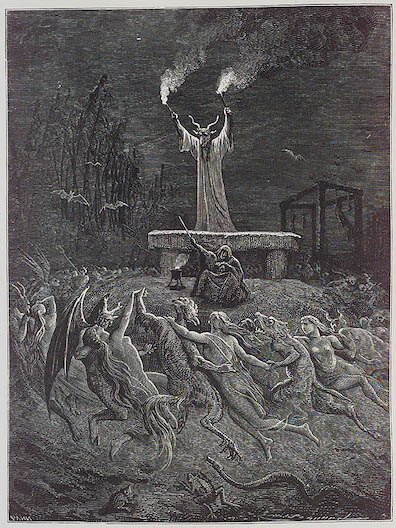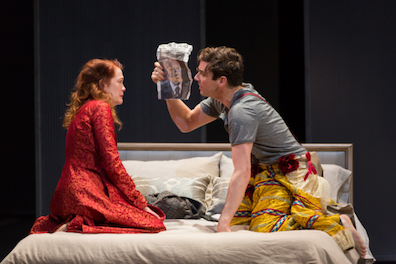Witching hour
Witching hour
In Brief
In Circe Bloom flirts lasciviously with Josie Breen
at "The witching hour of night." In Hades he imagines
John O'Connell and his wife making love in "The shadows of the
tombs when churchyards yawn." The words of both passages
derive from the soliloquy in which Hamlet prepares to chastise
his mother for marrying Claudius. The spooky horror of this
soliloquy becomes linked with sexual passion in Bloom's
thoughts, probably because of the Oedipally suggestive
encounter between Gertrude and Hamlet that takes place shortly
afterward in her bedroom.
Read More
Walking among the tombstones, Bloom indulges a long fantasy about what it would be like to be married to the cemetery's caretaker:Fancy being his wife. Wonder how he had the gumption to propose to any girl. Come out and live in the graveyard. Dangle that before her. It might thrill her first. Courting death... Shades of night hovering here with all the dead stretched about. The shadows of the tombs when churchyards yawn.... Want to keep her mind off it to conceive at all. Women especially are so touchy. Tell her a ghost story in bed to make her sleep. Have you ever seen a ghost? Well, I have. It was a pitchdark night. The clock was on the stroke of twelve.The phrase "churchyards yawn" directs readers to the soliloquy in which Hamlet tries to work himself up to a gothic pitch of murderous horror before visiting his mother. He imagines the "witching hour" or "devil's hour" of folklore, when black magic causes graves to open and ghosts to wander the earth:
'Tis now the very witching time of night,
When churchyards yawn and hell itself [breathes] out
Contagion to the world. Now could I drink hot blood,
And do such [bitter business as the] day
Would quake to look on. Soft, now to my mother.
O heart, lose not thy nature! let not ever
The soul of Nero enter this firm bosom,
Let me be cruel, not unnatural;
I will speak [daggers] to her, but use none. (3.2.388-96)
The Roman emperior Nero had his mother murdered, which
explains why Hamlet thinks of him as he tries to excite
violent anger in himself. But Nero was also rumored to have
harbored sexual desire for Agrippina (his biographer Suetonius
reports that he was persuaded not to act on these feelings),
suggesting that an undercurrent of transgressive libido may
also be flowing through Hamlet's thoughts. Both kinds of
energy surface two scenes later in Gertrude's bedroom, where
Hamlet's threat to "set you up a glass / Where you may see the
[inmost] part of you" makes Gertrude fear that he is about to
carve her up (3.4.19-21), and where his uncontrolled emotional
onslaught makes many watchers feel that they are witnessing an
Oedipal revelation. Bloom thinks of sexual desire, twice, in
connection with Hamlet's lines "the very witching time of
night, / When churchyards yawn" because Shakespeare has
planted that seed.
The "witching time of night" has been variously understood. In some folk traditions it lasted until first light, as at the end of A Midsummer Night's Dream. But Hamlet seems to refer to a more specific time. Christians often identified the hour as 3-4 AM because it represented a Satanic inversion of Christ's death at 3 PM. Other teachings held that it began at midnight. If Joyce's "witching hour of night" refers to any of these, it must be 12-1. Bloom imagines John O'Connell setting the scene for a ghoststory: "It was a pitchdark night. The clock was on the stroke of twelve." In Circe he is remembering a Christmas party: "After the parlour mystery games and the crackers from the tree we sat on the staircase ottoman. Under the mistletoe." Not only is 12-1 a more likely time than 3-4 for kissing under the mistletoe at a holiday house party, but it suits the present novelistic time in which Bloom is recalling the event. According to the schema published in Stuart Gilbert's book, Circe––a chapter of nighttime magic and sexual license––begins at 12 PM. Bloom's encounter with Mrs. Breen happens early in the chapter.

Source: www.flickr.com.

